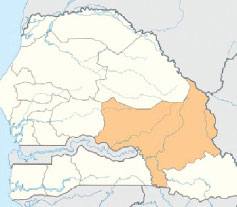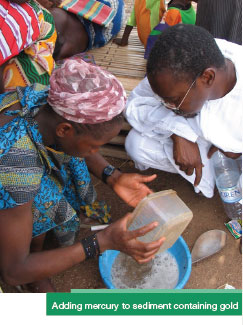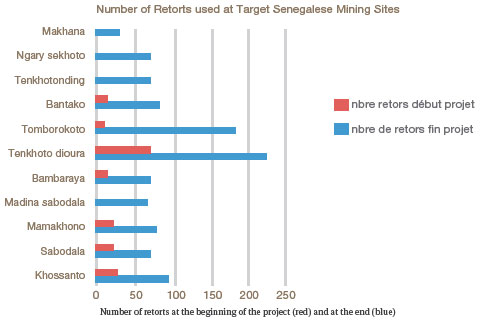Mercury Risk Mitigation
Kedougou, Senegal
The Kedougou region of Senegal was chosen for a pilot mercury project because of its large gold deposits and the many artisanal gold miners in the area, who use mercury in the gold extraction process. The Saboldala gold deposit in Kedougou is estimated to yield about one million ounces of raw gold over a 230 square kilometer area.
As described earlier in this report, artisanal gold miners extract gold-laden rock, grind it into fine sand, and then mix it with mercury to form an amalgam. The amalgam is then subjected to high heat, either with a blow torch or over an open flame, and the mercury evaporates into the atmosphere, a process that leaves behind a substance that is roughly 80% pure gold.
The use of mercury capture technology known as a “retort” during the mercury burn-off stage is a simple and highly cost-effective method of controlling the release of mercury into the environment. This device allows for the efficient capture and reuse of mercury while minimizing occupational exposure.

Project Strategies
The primary goals of this project were both to sensitize workers and their families to the harmful health effects of mercury exposure, and to popularize the use of the mercury retorts among miners. To achieve this, Blacksmith Institute staff and partners organized local meetings to discuss the use and importance of the retorts. Workers were also shown the process of fitting retorts for their use over their current instruments.

Using this approach, project staff organized nine information sessions over the course of three months, which were designed to reach almost 4,000 people in eleven villages across the region. Project staff visited 23 artisanal mining sites to support the miners and gather information relative to the evolution of the retorts and to the quantity of mercury circulating around the villages.
Outcomes and Follow-Up
This project resulted in an increase in the use of retorts at all sites; however, the usage at each site remained highly varied. At some sites, 95% of miners employed retort technologies in the process, while at others only 5% adopted its use. Over the entire area, the number of total retorts has increased by over 400%. The introduction of retorts in small-scale gold mining communities has been very successful. To encourage further progress, work in Senegal must continue. Retorts in larger quantities and sizes are in high demand, which will require additional support from donors and other stakeholders. Regulation of the sale, stockpiling, and usage of mercury must also be implemented.
Further steps that Blacksmith Institute will implement in 2010 include:
- Supporting miners in acquiring better retorts;
- Executing studies that monitor local mercury levels;
- Continuing to educate miners on the benefits of retorts;
- Equipping workers with gloves and masks to minimize direct exposure;
- Continuing to work with local authorities, media, and existing partners;
- Creating a health panel to detect signs of high levels of contamination; and
- Creating a system that formalizes and controls the circulation of mercury.




